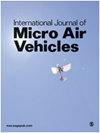用UB-ANC仿真器模拟无人机机群
IF 1.5
4区 工程技术
Q2 ENGINEERING, AEROSPACE
引用次数: 4
摘要
多旋翼飞行器控制的最新进展以及硬件、传感和电池技术的小型化,为民用和业余应用提供了廉价、实用的微型飞行器设计。与此同时,正在设想几个应用程序,将多个联网的微型飞行器聚集在一起,协同完成大型任务。然而,同时部署多个微型飞行器仍然非常具有挑战性。为了应对这一挑战,我们开发了一个开放的软件/硬件平台,称为布法罗大学的机载网络和通信试验台(UB-ANC),以及一个相关的仿真框架,称为UB-ANC Emulator。在本文中,我们提出了UB-ANC仿真器,它将多微型飞行器规划和控制与高保真网络仿真相结合,使从业者能够在软件中设计微型飞行器群应用程序,并提供在实际硬件上部署的无缝过渡。我们根据在两种任务场景中收集的实验数据证明了UB-ANC Emulator的准确性:一种是使用三个联网微型飞行器的简单任务,另一种是通过单个微型飞行器的复杂覆盖路径规划任务。为了准确反映微型飞行器群的性能,其中通信链路会受到干扰和数据包丢失,数据链路、网络和传输层的协议会影响网络吞吐量、延迟和可靠性,我们将开源离散事件网络模拟器ns-3集成到UB-ANC模拟器中。我们通过节点到节点和端到端测量展示了UB-ANC仿真器如何用于模拟多个联网微型飞行器,并对ns-3中定义的移动性、控制、无线信道特性和网络协议进行准确建模。本文章由计算机程序翻译,如有差异,请以英文原文为准。
Simulating unmanned aerial vehicle swarms with the UB-ANC Emulator
Recent advances in multi-rotor vehicle control and miniaturization of hardware, sensing, and battery technologies have enabled cheap, practical design of micro air vehicles for civilian and hobby applications. In parallel, several applications are being envisioned that bring together a swarm of multiple networked micro air vehicles to accomplish large tasks in coordination. However, it is still very challenging to deploy multiple micro air vehicles concurrently. To address this challenge, we have developed an open software/hardware platform called the University at Buffalo’s Airborne Networking and Communications Testbed (UB-ANC), and an associated emulation framework called the UB-ANC Emulator. In this paper, we present the UB-ANC Emulator, which combines multi-micro air vehicle planning and control with high-fidelity network simulation, enables practitioners to design micro air vehicle swarm applications in software and provides seamless transition to deployment on actual hardware. We demonstrate the UB-ANC Emulator’s accuracy against experimental data collected in two mission scenarios: a simple mission with three networked micro air vehicles and a sophisticated coverage path planning mission with a single micro air vehicle. To accurately reflect the performance of a micro air vehicle swarm where communication links are subject to interference and packet losses, and protocols at the data link, network, and transport layers affect network throughput, latency, and reliability, we integrate the open-source discrete-event network simulator ns-3 into the UB-ANC Emulator. We demonstrate through node-to-node and end-to-end measurements how the UB-ANC Emulator can be used to simulate multiple networked micro air vehicles with accurate modeling of mobility, control, wireless channel characteristics, and network protocols defined in ns-3.
求助全文
通过发布文献求助,成功后即可免费获取论文全文。
去求助
来源期刊

International Journal of Micro Air Vehicles
ENGINEERING, AEROSPACE-
CiteScore
3.00
自引率
7.10%
发文量
13
审稿时长
>12 weeks
期刊介绍:
The role of the International Journal of Micro Air Vehicles is to provide the scientific and engineering community with a peer-reviewed open access journal dedicated to publishing high-quality technical articles summarizing both fundamental and applied research in the area of micro air vehicles.
 求助内容:
求助内容: 应助结果提醒方式:
应助结果提醒方式:


